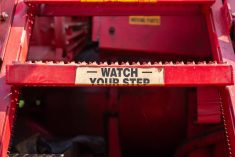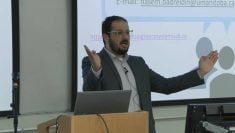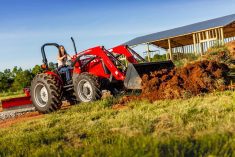A widow we’ll call Susan, 64, has a 1,120 acre farming operation in central Manitoba. She owns 800 acres personally and has another 320 acres in her farming corporation. When her husband — we’ll call him Burt, passed away, the estate was probated and quickly transferred to Susan. Now she wonders what will become of the farm. Her four children all have off-farm careers and no interest in maintaining the family farm.
Susan has a long-term goal of winding down the farm. The corporate land was sold with a plan to wind up the corporation. Her personally owned land was to be kept for passive rental income to be used for her retirement. She was told by her accountant to pay out remaining earnings of $200,000 over four years.
Read Also

Gentle treatments for pain in the neck
Heading toward year-end, people unknowingly tense up against the cold and busyness, causing neck pain that can often be treated with appropriate support and gentle mobility, athletic therapist Kathlyn Hossack says.
Susan is in good shape in financial terms. She spends modestly and plans her financial future actively with advisors. But taxes are a problem. Last year, her accountant suggested that Susan take a $110,000 dividend from the farming corporation. That generated a $44,000 tax bill. That liability prodded Susan to seek further advice to manage future taxes and her retirement.
The advice
Susan’s advisors, Erik Forbes and Don Forbes of Don Forbes & Associates/Sterling Mutuals in Carberry, Manitoba, note that all corporate assets have already been converted to cash. There is a remainder of $85,000 of retained earnings to be paid out over the next three years as taxable dividends. Susan can continue the corporation or use it as an investment holding company. However, Susan does not want to pay a lot of accounting fees and live with the complications of the corporate structure if the company can be wound down easily.
In order to reduce the taxes on payout of retained earnings, she can make offsetting RRSP contributions. That would not eliminate the tax liability, but it would postpone it until, in retirement, she could withdraw the money at a lower tax rate. This has the same effect of continuing the corporation but without hefty accounting bills. Currently, Susan has $75,000 of RRSP space and will generate more room in the next few years.
For 2015, Susan can take $30,000 of dividends and make an equal contribution to use the space. For 2016, she would take $30,000 of dividends and make a $25,000 RRSP contribution. In 2017, she would take $25,000 of dividends and make a $20,000 RRSP contribution.
In the year Susan turns 65, she can convert the RRSPs to a Registered Retirement Income Fund and start paying out $6,000 a year, $2,000 of which would be free courtesy of the pension income credit. Susan will also receive an age credit of $7,033 when she turns 65. That can be applied to taxable income from any source. $85,000 of RRSP purchases will support a $500 monthly RRIF payment for the next 20 years, Don Forbes notes.
Susan is a good custodian of her money. She should hold a cash reserve of at least six months of living expenses, perhaps even more given that she receives rent from her leased land only once a year.
Liquidity is important. Susan should keep at least $20,000 in her chequing account and $50,000 to $100,000 in a so-called high interest savings account that would yield perhaps one per cent per year. She also has $370,000 of non-registered investments outside of the family farming corporation. There is $270,000 in chequing, a Locked-In Retirement Account of $55,000 and $85,000 of cash still in the company. She has sufficient cash to top up her Tax-Free Savings Account to its $46,500 contribution limit as of 2016.
The investment advice
Susan has had competent investment advice. Her accounts hold blue chip stocks in low-cost pooled funds. They generate Canadian source dividends which, due to the low fees for the funds, have modest deductions for administration. She has a term life insurance policy with premiums level to age 100. The policy has no cash value. She has paid $667 in premiums each year for $90,000 of death benefit. The money could be used for settling her estate when she dies, but there are less expensive ways to get the same result.
Her Tax-Free Savings Account, which is yet to be established, would do the same job as life insurance without the premiums. On the other hand, she would be giving up the benefit of immediate payment of $90,000 should she die in the near future. Her life expectancy is nearly 90, she does not smoke, and she is very healthy. If she does keep the policy for another 25 years, she will have paid another $16,675. In the end, if the risk of early death is ignored, the policy returns the premiums paid. It does not return foregone income. That’s the cost of shifting the risk to the insurance company. The choice is hers, Erik Forbes explains.
Should Susan elect to give up life insurance and save the premiums, she should invest to achieve a known result with minimum risk. She could lose a lot or make a lot in stocks. But actual government bonds, bought with a series of terms from five years to 10, 15 and 20 years, will generate income and mature at precisely known values. Bond investment funds can accrue gains or losses forever, so Susan should stick to actual bonds. The returns are not going to be spectacular, but inside of RRSPs, for example, interest paid and any gains realized from price appreciation at maturity will not be taxed until paid out in RRIFs. It’s a security conscious alternative to life insurance.
At retirement, Susan will have an estimated $754 in Canada Pension Plan benefits each month, $570 of Old Age Security benefits at present rates, $275 a month from her Life Income Fund, $500 a month from her RRIF and an estimated $1,500 a month from land rented out. That’s $3,599 a month. After 15 per cent average tax, she would have $3,060 a month for expenses, more than enough for Susan to continue living as she does in a paid-for house with no large outlays expected, Don Forbes notes.
For large future expenses, perhaps a new or newer car from time to time, a bit of travel or gifts to her children, she has abundant investments and liquidity. If she wishes to take holidays in the U.S., she can achieve a natural hedge against the rising value of the greenback by investing in dividend-paying U.S. stocks in a U.S. funds account. A US$100,000 account generating three per cent per year would provide money for several weeks south of the border, especially if she elects to drive rather than to fly.
“You have to give Susan a lot of credit for her foresight,” Don Forbes says. “She has received good advice, has worked to anticipate and control income taxes, dealt with the fact that her children will not take over the family farm, and has even anticipated and worked out a way of funding her own funeral expenses and potential distribution costs for her estate. Relatively few farm families and fewer widows do all of his. Our advice to her is to stay the course, pay out farm corporation earnings in a tax-efficient manner, examine the risk and returns of investments, and live well in a life well planned.














